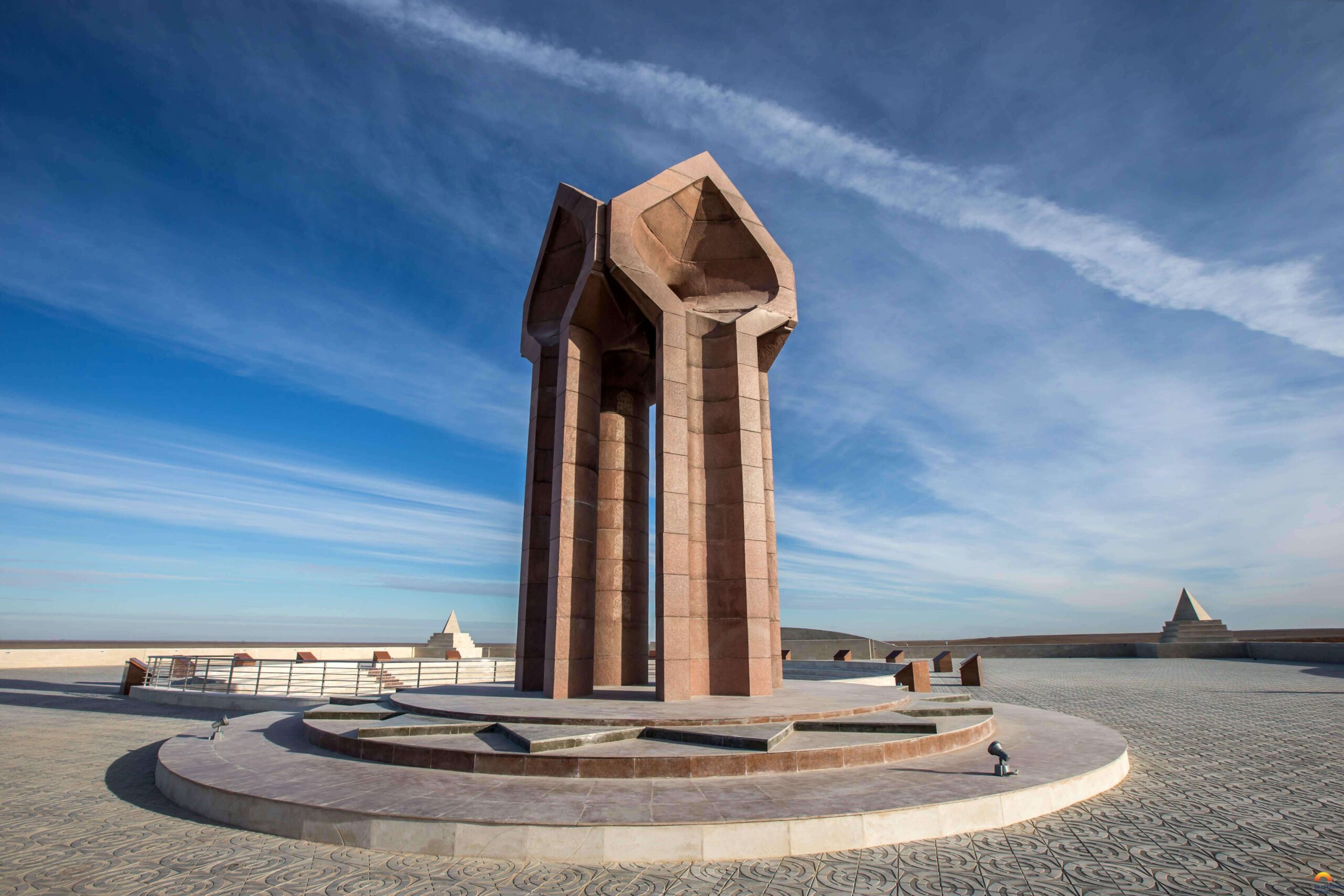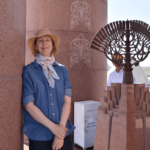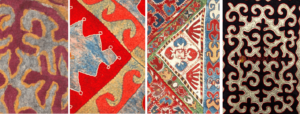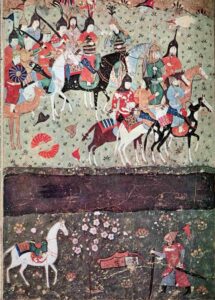Readers who are aware of Kazakhstan’s nomadic cultural history will no doubt realize that the nomadic way of life profoundly shaped every aspect of their customs, traditions, beliefs and practices. In particular, Kazakh musical instruments – and the musical repertoires that they perform – can provide a unique insight into that nomadic cultural history, as well as the many ways that nomadic cultural influences continue into 21st century musical expression in Kazakhstan. In general, Kazakh traditional musical instruments were constructed to be sturdy and portable, so that they would not be damaged during long and frequent nomadic migrations. Instruments were usually constructed out of materials that were readily available such as animal hair and skin, wood or reeds, clay, and other items from nature; these were occasionally supplemented by materials such as metal, which nomads would have obtained through trade with sedentary dwellers. Kazakh musical instruments also served important functions in the two of the main foundations of nomadic culture: storytelling and animism (belief systems based in the idea that elements of nature possess spiritual power). Kazakh nomads used musical instruments to accompany recitations of epic poetry, narrative songs, and instrumental pieces that wordlessly conveyed vivid scenes and complex moods; all of these were passed down through the generations using oral tradition and memorization, rather than written notation. Some musical instruments were also utilized in rituals associated with Tengrism and other animist belief systems. While the most well-known Kazakh instrument, the two-stringed plucked lute dombyra, was more commonly associated with the narrative aspects of Kazakh nomadic culture, the less-common two-stringed horsehair fiddle qyl-qobyz is more often connected with the spiritual and ritual aspects.

Qyl-qobyz. (From the collection of the Ykhlas Museum of Kazakh Folk Instruments. Photo by the author.)
As the primary vehicle for shamanic ritual, the qyl-qobyz is believed to possess the power to communicate with the spirits of nature as well as ancestor spirits. The qyl-qobyz is thought to be thousands of years old, having been created by the legendary figure Qorqyt-Ata after his lifelong journey to discover immortality; after realizing that his search was in vain, he sacrificed his beloved camel and stretched its hair and skin across a piece of wood from a tree and played mournful melodies that echoed the sounds of wind, animals, and the laments of a grieving person. Part of the reason that the qyl-qobyz is believed to have spiritual properties and power is its remarkable ability to produce these sounds of nature and profound emotion; that ability, in turn, comes from the fact that its two horsehair strings are able to produce a rich spectrum of overtones, or harmonics, that sound like whistling echoes floating in the air. For this reason, the qyl-qobyz was used by shamanic folks healers called baqsylar during nomadic times, and it is still believed to have sacred and therapeutic properties by numerous performers and listeners today. In contemporary practice, the qyl-qobyz may be utilized in performances of traditional programmatic compositions called küi (“mood”), as well as modernized genres such as contemporary art music and even pop music.Saryn, a traditional küi
“Solie” (Speak) composed and performed by Tokzhan Karatai
“Menin Alemim” (My World), performed by Akerke Tazhibayeva
The ancient origins, sacred associations, and healing powers of the qyl-qobyz make up the central focus of the professional career and creative work of performer, küi composer, and associate professor at the Kazakh National University of the Arts, Raushan Zhumabekkyzy Orazbayeva (b. 1973).

Raushan Orazbayeva playing a qyl-qobyz. (Photo by the author.)
Born in Almaty, Kazakhstan, Orazbayeva learned to play qyl-qobyz as a child, later studying at the Zhubanov Republic Music School and graduating from the “Folk music” department of the Kurmangazy State Conservatory. She is now an Honored Worker of the Republic of Kazakhstan and the laureate of numerous domestic and international competitions. Orazbayeva’s approach to the qyl-qobyz emphasizes its ability to imitate nature – specifically the calls of the whooper swan that is native to Eurasia – as well as the therapeutic potential of the instrument’s sound. She points out that, during nomadic times, the swan was considered a “totemic” or “sacred” bird that symbolizes dignity and purity (Orazbayeva 2018: 4). There are numerous traditional küi compositions for qyl-qobyz that imitate the sounds of the whooper swan (Cygnus cygnus) through various “effects and techniques” such as rapid hand and finger movements as well as precise bowing methods (Orazbayeva 2019: 202-3).whooper swan calls
In addition to that significant history, she has also observed first-hand that “[the] experience of performing on different stages of the world has helped me to realize that the imitation of the clicks of swans greatly affects the audience, their spiritual and emotional state. The sound of kobyz itself has a meditative quality.” (Orazbayeva 2019: 203).
For this reason, her 2018 publication Aqqular Sazy (Swan Tunes) compiles musical scores for several dozen traditional and modern compositions by Kazakh composers that depict the movements and sounds of swans, as well as traditional stories about swans. Although many of the compositions were originally created for the dombyra, they have been re-arranged by Orazbaeyeva for performance on the qyl-qobyz. In the book, Orazbayeva explains in detail how to achieve the “effects and techniques” that are required to create the haunting sounds of the swan’s calls in the compositions, and she performs all of the compositions on the accompanying CD. According to Orazbayeva, part of the skill required to reproduce the sounds of a swan is learning a special technique that she calls “micro-intonation” (Orazbayeva 2018: 14) – this refers to a slight bending of a musical note so that it falls slightly between the notes that can be played on a European piano. These “in-between” notes are crucial to the accurate musical portrayal of the swan, and to the emotional and spiritual power of the composition overall.
Orazbayeva has described numerous instances in which she has witnessed audience members – both Kazakh and non-Kazakh alike – shedding tears during her performances. She interprets these reactions in a positive way; to her, the tears are a sign that a person’s pain is being released, and that her music is a form of therapy. In a very similar way, during nomadic times a traditional baqsy folk healer would treat an ailing person’s suffering by playing the qyl-qobyz to communicate with the spirit world, asking for guidance and relief from suffering.
In Orazbayeva’s view, traditional küi compositions should not be considered “fixed,” like many Western European compositions. Instead, she says, a küi should be “an improvisational art that has a special place in our culture” (Orazbaeva 2019: 203). She compares the structure of an individual küi to a tree – its roots are in the mystical saryn melodies used by baqsylar in shamanic healing rituals; its branches and leaves are the basic melodic phrases of the küi and its variations (Orazbaeva 2019: 203).
A striking example of a swan-themed küi is simply titled “Aqqu” (Swan), a vividly descriptive folk küi (meaning that the composer is unknown).https://web.archive.org/web/20210422210536if_/https://player.vimeo.com/video/366692385
Raushan Orazbayeva performing the folk küi “Aqqu” (The Swan)
This composition uses the full sonic capabilities of the qyl-qobyz to depict the calls and movements of a swan amid a larger story about a boy who attempts to hunt a swan with his bow and arrow; hunting swans is traditionally considered bad luck by Kazakhs, but the boy was desperate to feed his family during a famine. After several unsuccessful shots (which are depicted through the plucking of the qyl-qobyz strings), the boy heads home, where he encounters a band of enemies. The story ends with the boy defeating his enemies and returning home safely to his family, and the composition ends with the qyl-qobyz playing the sounds of swan cries growing more and more faint (as if the swans are flying away) and a final pluck of the strings. “Aqqu” demonstrates a number of the distinctive features of the qyl-qobyz and its traditional küi repertoire. From its opening notes, this composition highlights the ability of the instrument to create a rich sound world of overtones/harmonics. The composition also demonstrates the ability of the qyl-qobyz to tell a story without words, and this story has some obvious connections to Kazakh nomadic culture. The implied moral of the story is that respecting the sacredness of nature (and the sacredness of the swan in particular) will ensure a good life; of course, this was an important message for nomadic Kazakhs who depended on nature for their survival. But the connection between “Aqqu” and nomadic culture also extend into the use of the qyl-qobyz by baqsylar to communicate with the spirits of nature during nomadic times.
Many listeners, both Kazakh and non-Kazakh alike, continue to be moved by the haunting, sometimes mournful, always deeply expressive tone of the qyl-qobyz and to be fascinated by its long and rich history in Kazakh traditional culture. Individuals who are interested in learning more about the qyl-qobyz and other Kazakh traditional instruments might consider visiting the following notable locations in Kazakhstan:
- The Ykhlas Museum of Kazakh Folk Instruments is a beautiful museum with an extensive collection of qyl-qobyz, dombyra, and many other Kazakh traditional instruments, many of which have important historical value. The museum also features collections of musical instruments from countries and cultures outside Kazakhstan, as well as a small performance hall for lecture-demonstrations. The Ykhlas Museum is located in Panfilov Park in Almaty, and is easily accessible by public transportation in the city.
- The Qorqyt-Ata Mausoleum and Memorial Complex is an impressive monument dedicated to the legendary creator of the qyl-qobyz. Shaped like three inverted qyl-qobyz, the monument is decorated by a set of hanging pipes that make a mysterious sound when the wind blows. The nearby museum presents a comprehensive history of Qorqyt-Ata and his significance to Kazakh cultural history. The Qorqyt-Ata Mausoleum and Memorial Complex is located several hours outside the southern city of Kyzyl-Orda, and is usually accessible only by car.
- The Folk Department of the Kurmangazy Kazakh National Conservatory in Almaty was the first of its kind in Kazakhstan, a training ground for the next generation of professional musicians who concentrate on Kazakh traditional instruments and instrumental music. Access to Conservatory buildings is restricted to students and faculty, but the Conservatory presents many concerts and recitals throughout the year that are free and open to the public.
References
Orazbayeva, Raushan. 2018. Aqqular Sazy (Swan Tunes). Astana.
Orazbayeva, Raushan. 2019. “Aqqular Sazy (Swan Calls).” Maqsat: An International Scientific-Methodological Journal. Vol. 34 (December): 202-205.






